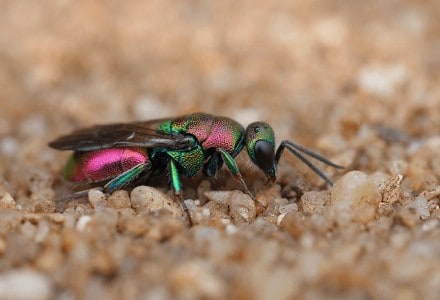
Cuckoo Wasp Facts
- Firstly, the term Cuckoo Wasp serves as the common name for any member of a rather extensive group of parasitic wasps. Furthermore, more than 3,000 species exist within this impressive group.
- Additionally, most of the varieties possess brilliantly colored bodies, with metallic sheens. Therefore, individuals sometimes refer to various species by another term. Metallic wasps constitutes the other name.
- Also, the common name of these amazing invertebrates has a rather unique origin. That’s because it derives from the unusual behavior displayed by the females of the genus when laying eggs.
- These the female typically lays within the nests of other species. The other insects, therefore, then act as unwitting hosts. This unusual behavior bears the name of kleptoparasitism.
Related Articles
Jewel Wasp Asian Giant Hornet Fig Wasp
Cuckoo Wasp Physical Description
Most notably, the physical appearance of the Cuckoo Wasp varies significantly. This occurs because the term collectively refers to an extensive group of species. However, certain basic physical patterns do exist.
Firstly, the great majority of the members of this group rarely exceed 0.5 in (1.2 cm) in length. The coloring also varies slightly among varieties. But, it most commonly includes metallic shades of green or blue. Yet red or pink appear occasionally.
Also, the abdomen remains quite flexible. This, therefore, allows the creature to curl into a tight ball as a means of defense. The pitted exoskeleton further provides it protection from most attackers.
- Kingdom: Animalia
- Phylum: Arthropoda
- Class: Insecta
- Order: Hymenoptera
- Family: Chrysididae
Photographer: gailhampshire
CC License: https://bit.ly/1ryPA8o
Cuckoo Wasp Distribution, Habitat, and Ecology
First of all, the various types of Cuckoo Wasp also live throughout a large range. As a result, it inhabits nearly all warm regions of the world. Yet, the majority inhabits desert regions. Some varieties, however, do prefer subtropical or Mediterranean climates.
In the state of California alone, in the United States, 166 species of this invertebrate exist. As a result of this fact, this represents the largest concentration of different species of this amazing group in North America.
Further, all known varieties live solitary lives. Also, nearly all feed as external parasites. Prey typically consists of the larvae of larger bees or wasps. Yet a handful of species also visit flowers for additional sustenance.
Species Sharing Its Range
Fennec Fox Blue Death Feigning Beetle Rose of Jericho
Check out our other articles on 5 Incredible North American Islands, Pangolin, Venus Flytrap, Barreleye Fish, Kimberly death adder, Noronha Elaenia, Limnonectes larvaepartus

